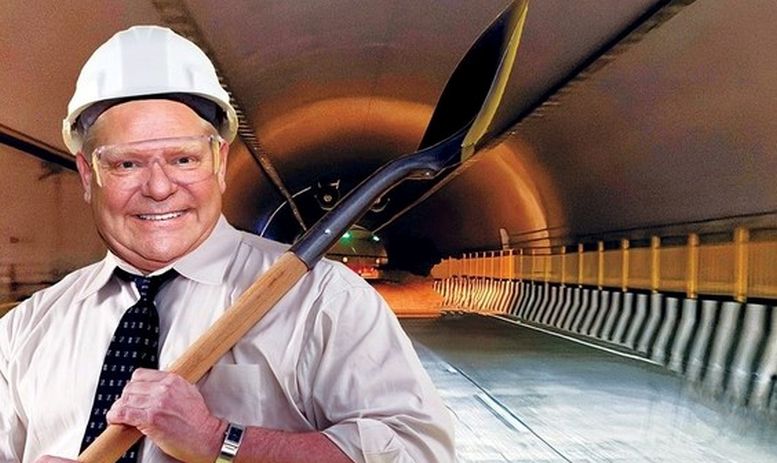Last April 1st, the Alberta-based Western Standard ran a story with the headline: “Federal budget commits funding to convert one lane of Trans-Canada Highway for bicycles.” The story continued to relate how the Liberal budget had set aside $100 billion to build bike lanes along the entire length of the Trans-Canada.
Hard to believe, eh? For sure, but note the date of the story. It wasn’t a news article: it was an April Fools spoof. Fast forward to this September in Ontario and, on first hearing, you might believe that the announcements of Doug Ford’s latest transport plans are another kind of spoof, a right-wing version of the story about the Trans-Canada bike lanes. But it’s no satire — the man is deadly serious. Within three days, there were two announcements — the first that he wants to stop the expansion of bike lanes and the second, showing off Ford the digger, the man who has a vision for a tunnel, aka tunnel vision.
Tunnel Madness
Ford, seemingly on his own, has come up with a brilliant plan to ease Toronto’s congestion problem. This one specifically deals with Highway 401, which stretches for 820 kilometres across southern Ontario and carries up to 500,000 vehicles daily. Ford’s target is the 55 kilometres of the 401 that runs through north Toronto. It is this section, with 18 lanes at its widest point, which earns the billing as the busiest highway in the world. And the plan? To build a tunnel under this stretch. It’s clear that Ford hasn’t heard of the fact of induced demand — building more highways or widening them does not reduce congestion as more cars use the route — this can create a constant spiral of more roads, more traffic and again more congestion.
Apparently for Ford, the present 18 lanes are not enough and 6 more are going to fix it. This is at an estimated cost, according to experts, of up to $60 billion. You don’t have to be a cynic to recognize that even the eye-watering $60 billion figure is quite conservative. One journalist commented that, when you work in the “Toronto Factor,” (cost and completion dates always underestimated) it means it would take 121 years to complete and end up costing $238-billion. The Ford proposal has been compared to Boston’s notorious “Big Dig.” In 1991, Boston began construction on a mega-tunnel. It took 25 years to complete and was the most expensive highway construction in US history. Ford was asked about this. His response: “That’s not going to happen here. We’re experts at tunnelling.” This is ironic given the incident reported by CBC News in its 2023 headline: “Trapped Toronto boring machine finally freed after 19 months, millions of dollars.” The tunnel boring machine had been stuck 18 metres underground since the spring of 2022.
Think of what the beleaguered Ontario health care system could do if given a fraction of that money — hire more nurses, cut wait times in emergency departments, fix the family doctor shortage, and expand mental health facilities. Health care spending per capita in Ontario was $4,889 in 2022-2023, the lowest in Canada, and 15.2 per cent, below the average of the other provinces.
The 401 wouldn’t be such a busy highway if both provincial and federal governments had given priority to the Eglinton LRT (light rapid transit), scheduled to have opened in 2020 and still far from complete, or extending the Sheppard subway line both ways, or actually building high-speed rail along the Québec City-Windsor corridor that has been studied to death for over 30 years and still has produced nothing. Canada is the only G7 country that does not have any high-speed rail.
Bike Lanes Reduce Congestion
The tunnel announcement was preceded by the one on bike lanes. The Ford plan is to introduce legislation that would ban municipalities from building new bicycle lanes that reduce the space for motor vehicles. Ford, in his usual ham-fisted and autocratic way, is dictating to municipalities what they are allowed to do with their own road infrastructure, as though his government knows better than the elected officials of towns and cities, each with unique travel and commuting patterns. If enacted, the Ford proposal will impact Toronto’s plan — approved by its council this summer — to add 100 kilometres of bike lanes to major routes over the next three years as part of efforts to reduce vehicle emissions and fight climate change. Ford’s reasoning: “We just want to get traffic moving. That’s what it comes down to, making sure you aren’t putting bike lanes in the middle of some of the busiest streets in the country.” But let’s not be too down on the man — he’s not totally against bike lanes. “Put them on secondary roads,” he says. It’s not that Toronto doesn’t have a major congestion problem. It does, such that it is listed as the number one city in the world in this field. Torontonians lost an average 98 hours in 2023 due to rush-hour traffic.
Ford is deluded if he thinks that a ban on new bike lanes will have the desired effect of easing congestion. It is understandable that motorists become resentful as cyclists or people in a dedicated bus lane speed by them while they are stuck in traffic — remove those lanes and the cars would move freely is the thinking.
However, all the evidence is that bike lanes reduce congestion. As Scott Stinson wrote in the Toronto Star: “Major cities that have committed to bike-lane expansion — Paris, London, Madrid, Seoul—have reduced vehicular traffic.” Bikes use far less space than a car, and most commuter cars have only one person, so more people can move on a bike lane than a highway.
There’s another issue for Ford — he claims that in addition to generating gridlock that bike lanes also get in the way of first responders. “Talk to our first responders that are pulling their hair out, …. It’s an absolute disaster, it’s a nightmare.” But the City of Toronto said emergency vehicles have had no issue with cycling infrastructure, present or developing, according to CBC News. “Emergency services are accustomed to manoeuvring through a variety of road conditions throughout the city on a daily basis and will continue to take the route that provides the fastest response.”
Of course, introducing bike lanes is not a magic bullet that can solve the traffic problem overnight. Stinson in his article continued:
It takes time for commuting behaviours to change after bike lanes are implemented. Motorists will grumble about the reduced space for their vehicles. This seems to be basically what Ford is reacting to — traffic congestion in Toronto is terrible, and also, at the same time, some bike lanes have been introduced, so therefore bike lanes must be to blame. But just because a certain segment of the Tory base thinks bikes are too woke doesn’t mean they are the problem. It’s much easier and politically expedient to complain about bikes taking away space from cars, because more people drive than cycle.
It seems that Ford has taken the line “four legs good, two legs bad” from George Orwell’s Animal Farm and adapted it to “four wheels good, two wheels bad.”
Montreal has been expanding dedicated bike lanes for years in a successful move to reduce vehicular traffic on the island. In one example, the installation of protected bike lanes along historic Saint-Denis Street has helped transform it from a thoroughfare for commuting motorists back to its original purpose as a commercial centre. Vehicular traffic is down, bike trips have skyrocketed, pedestrian traffic is up, and the commercial occupancy rate has steadily increased. The Montreal experience is not a one-off. Studies around the world have shown that cyclists and pedestrians are more likely to stop and shop than just passing-through drivers. You would think that Ford, the premier whose mantra is that Ontario is open for business, would approve of this.
Ford doesn’t hide the fact that he’s a dyed in the wool car fan who has already removed road tolls, waived licence-plate fees, widened Highways and is all set on building another highway, stretching for 55 kilometres north of Toronto, the proposed 413. But there’s method in his madness. He’s looking ahead to the next election when he can appeal to his right-wing populist base highlighting “wokeness” and “the war against cars.”
Real Solutions
The Ontario Liberals have proposed a $1 transit fare (a “buck-a-ride”) on all transit lines in Ontario. The current adult fare is $3.25. They claim it will take 400,000 cars off the road each day — but where will those extra 400,000 riders go? Currently, passengers on much of the transit system during rush hours are already packed like sardines in a can because of the system’s chronic underfunding. In smaller towns and cities there may be a bus only once every one or two hours — if there are buses at all. A $1 fare doesn’t do you much good if service is so intermittent that you can’t get to work on time unless you leave an hour early!
Ontario needs a comprehensive people-centred transit plan. While protected bike lanes have a role, they are not for everybody and for every occasion. People with physical limitations, young children, or those carrying a lot of shopping all are unlikely to ride a bike. In winter, drivers need options other than a bike lane. The core of successful urban mobility is public transit.
Socialist Alternative would not pour $60 to $238 billion down the tube of Ford’s huge and impractical tunnel. That money would go to funding a dramatic improvement in public transit. This would shift people out of cars, reduce air pollution, help tackle climate change, improve the urban environment and boost local neighbourhoods.
Socialist Alternative’s program includes:
- Accelerate and extend public transit projects already planned or under construction
- Provide more frequent and reliable bus services
- Invest in publicly owned, free, high-speed transit networks within cities and between urban and rural areas
- Support new bike lanes
- Finance such projects by using Ford’s tunnel billions and implement the TTC Riders’ (a Toronto transit campaign group) proposed one percent income tax hike on high earners, which could raise $580 million a year
These actions — along with building affordable housing, adding more green spaces and pedestrianized spaces and expanding leisure and cultural amenities — would make the city a more vibrant and attractive place to live. All of these would entice many suburbanites to abandon their cars (or, at least one of them) and move back to the city.




